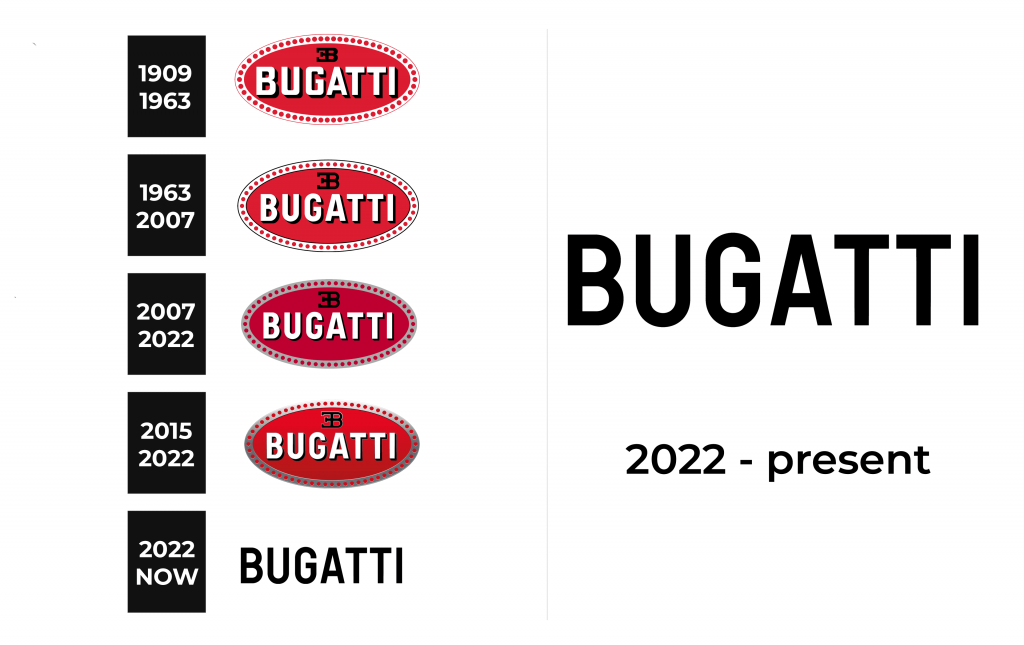The Bugatti logo signifies the combination of elegance and technology. It is underlined by the oval shape, 60 pearls and the stylized initials of Ettore Bugatti.
Meaning and History

It has the form of a wide oval with white letters and a red background that has not changed much over the decades. The founder himself (Ettorio’s father) was responsible for its design and came up with the idea of creating this shape by cutting a cylinder 45 mm in diameter at an angle of 30 degrees.
The rest is completed with a white lettering in white (a symbol of elegance and nobility) on a red background (strength and passion), black initials of the founder (perfection and courage) and a whole sixty dots, symbolizing excellence and grandeur of their automobiles.
1909 – 1963

The first logo was created by Carlo Bugatti, the father of the auto designer Ettore. He used a horizontal oval shape for the base. It had a white border with sixty red dots that could symbolize bolts used to secure elements in the automobiles or precious stones that the logo creator used when creating jewelry. In either case, it was an interesting detail that made the logo more interesting. The red background behind the white lettering reflected the power and speed of the Bugatti automobiles and was a good attention grabber. For the name, Carlo Bugatti chose a strict, sans-serif font and all uppercase letters. A black shadow cast to the right gave the letters volume and allowed them to stand out on a bold background. He also did not forget to add the initials of Ettore Bugatti who gave birth to this brand. They were done in black and the “E” was mirrored.
1963 – 2007

The logo has undergone minor changes. The most noticeable was the modification of the font, which acquired rounder forms and was slightly smaller. In addition, the white border was now framed by thin black lines instead of red. This seemingly negligible update created a more professional and cohesive look, connecting the black elements inside the emblem with the outside border.
2007 – 2022
2015 – 2022

The update gave the impression that the emblem was placed in a shadow with the lights being only on the name. This was achieved by making the white border light gray and removing the black outline altogether. The red color of the background also looked darker and not as vivid. The lettering, though, remained unchanged and stood out more than ever.
2022 – Today

A more stylish and modern look was presented in 2015, although the general idea of the original logo was still preserved. The gray part of the border was now metallic silver. It seemed that the red dots on the border were just perforated holes in the silver border and the red background was visible through them. The background, by the way, got lighter and acquired a bit of orange tint to it. The company preserved the way its name was printed.
Emblem and Symbol

It should be noted that one of the Bugatti models besides the “necklace” logo also had a “circus elephant” statuette. The elephant symbol created by the younger brother of Ettore Bugatti, an animal sculptor Rembrandt Bugatti, decorated the radiator cap of Royale Type 41, the high-end car of the era created in 1926.
The Legends
Bugatti veyron logo
The airflow system and exhaust system of that car were modified, as well as several other engine components, which allowed the eight-liter engine to draw 1,109 horsepower.
The Bugatti Veyron tuned by Mansory also underwent a series of styling operations. There are carbon accessories (bumpers, sills). Some models have the “V” logo and LED daytime lamps appeared on the grill. There is the solid badge made of silver that has a very high quality design due to its size. The car is mounted on specially designed wheels. Inside there is light leather upholstery and carbon fiber inserts.
Type 13 Brescia
It was developed before the First World War, whose drivers became famous in 1921, when they outclassed their rivals in the Grand Prix Bresci, taking the first four places.T
Type 35
It won several hundred races in various variants, breaking all possible records.
Bugatti Type 41 Royale
Unfortunately, it hit the Great Depression period and instead of the planned 25 units, 7 were built, of which only three found buyers.
Bugatti Type 57
More than 700 units of this model were produced, in a few, often very different externally, variations.
Bugatti Chiron
The current Bugatti model could be called the Veyron on steroids.


